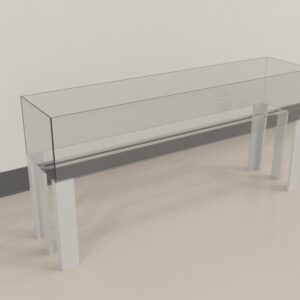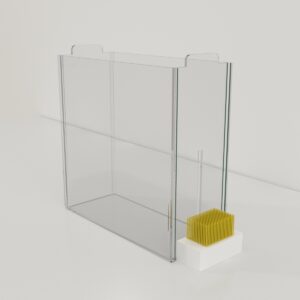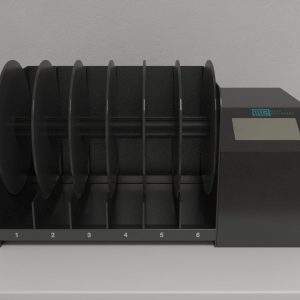$790.00 – $890.00Price range: $790.00 through $890.00
The Emergence Test is a specialized experimental method designed to evaluate neophobia and exploratory behavior in rodents. It builds upon the Open-field test, a well-established assay used to study anxiety and exploratory tendencies. Rodents have a natural inclination to explore but also display a strong aversion to brightly lit, open spaces. The Emergence Test leverages these traits to assess how rodents respond to new environments.
The Rodent Emergency Test is another behavioral assessment used to examine rodents’ ability to navigate complex environments. This test provides insights into cognitive and motor skills and can reveal any effects resulting from exposure to substances or other experimental conditions. It typically involves guiding the rodent through a maze with the promise of a food or water reward upon completion. This test is valuable in fields such as neuroscience, toxicology, and behavioral biology for studying learning, memory, and the impact of various substances on behavior.
Maze Engineers provides the Emergency Test Maze for conducting these assessments.

MazeEngineers empowers preclinical neuroscience research with meticulously designed, customizable behavioral apparatuses. From manual classic mazes to fully automated smart systems, we provide the tools scientists need to capture high-quality, reproducible data for studies on learning, memory, anxiety, and depression.



Mouse |
40×40 cm; 30cm height |
Cylinder: 13.2 x 4.4 x 4.4 cm |
Rat |
60×60 cm; 40cm height |
Cylinder: 21 X 7 X 7 cm |

The Emergence Test is designed to minimize handling of the subject. It involves placing the animal in a holding container before introducing it into an open arena. The holding container offers a secure environment compared to the more exposed open-field arena. The primary task is to measure how long it takes for the subject to leave the container and begin exploring the arena. Animals with elevated anxiety levels typically remain in the container longer, avoiding the open space. This test is useful for assessing the impact of anxiogenic and anxiolytic substances on behavior, as well as for investigating lesion-induced behaviors and neuropsychiatric conditions.
The apparatus for the Emergence Test includes a spacious open field with high walls and a cylindrical holding container, all made from opaque acrylic. Other commonly used tests for evaluating locomotion and anxiety-related behaviors include the Elevated Plus Maze, the Zero Maze, and the Light/Dark Box.
The Emergence Test apparatus is made from opaque acrylic and features an enclosed open field. The high walls of the field keep the subject contained and eliminate external visual cues that could affect the subject’s behavior. The holding container is an opaque cylinder, measuring 21 x 7 x 7 cm, which houses the subject. The cylinder is fitted with lids and is firmly fixed to the apparatus to prevent any movement or rolling.
Before starting the trials, thoroughly clean the apparatus using a 70% ethanol solution. It is important to clean the equipment between trials to avoid any residual stimuli affecting performance. Ensure the maze is well-lit with overhead lighting to eliminate shadows. For detailed observations, a video and tracking system like Noldus EthoVision XT can be utilized.
As the Emergence Test is designed to assess neophobia, pretraining of the subject is not necessary.
Carefully position the subject into the holding cylinder and securely close the lid. Handle the container with care to avoid any abrupt movements that could stress or harm the subject. Position the cylinder in the center of the open arena and lift the lid. Monitor the subject for a minimum of 25 to 30 minutes. Once the trial is finished, take the subject out of the arena and return it to its home cage. Since the Emergence Test assesses responses to novel environments, conducting repeated trials may not yield additional benefits.
Pare et al. investigated the impact of psychotropic drugs on neophobic behavior using male Wistar Kyoto (WKY) and Sprague Dawley (SD) rats. The subjects were assigned to groups and received injections of either 0.5 cc saline, 5 mg/kg fluoxetine, 10 mg/kg desipramine, 15 mg/kg nomifensine, or 2 mg/kg diazepam over an 8-day period. Testing was conducted 1 hour after drug administration on the eighth day using the Emergence Test, conducted in an unlit arena.
During the 25-minute trials, diazepam was found to increase emergence latency and significantly reduce activity in WKY rats. In contrast, SD rats showed a decrease in emergence latency and increased activity with diazepam administration, while nomifensine led to a marked rise in activity in these rats. These findings suggest strain-dependent behavioral differences: SD rats exhibited more anxiety-like responses, whereas WKY rats demonstrated signs of behavioral depression.
Leibrock et al. examined the influence of Akt2 on mouse behavior by comparing Akt2 knockout mice (akt2-/-) with wild-type mice (akt2+/+). Over a four-month period, various behavioral assays, including the Emergence Test, were used to assess their behavior. Results from the Emergence Test revealed that akt2-/- mice spent considerably more time in the holding container compared to akt2+/+ mice and made fewer entries into the open arena. The findings from these behavioral assays suggest that Akt2 plays a significant role in modulating anxiety and depressive-like behaviors.
Robert Holson investigated the behavioral changes caused by lesions in the mesial prefrontal cortex (MFC) using adult male Long-Evans rats. The rats were divided into two groups: one underwent MFC lesion surgery, while the other received sham surgery. The Emergence Test was performed under three different conditions: high fear with high novelty, moderate fear with low novelty, and moderate fear with high novelty.
Under conditions of high fear and high novelty, rats with MFC lesions remained in the safe space and did not venture into the open area. A similar pattern was observed in the moderate fear and high novelty condition. However, there was no significant difference in behavior between the MFC-lesioned and sham-operated groups under the moderate fear and low novelty condition. The results suggested that the latency to emerge for the MFC-lesioned rats was influenced more by the aversiveness of the environment than by its novelty.
The exploratory behavior and responses of spontaneous hypertensive mice (SHM) compared to normotensive controls were evaluated using both the Open-Field test and the Emergence test. The study included mice of both sexes at 3 months and 12 months of age. Following the Open-Field test, the mice were tested in the Emergence test, where their emergence latencies, categorized by the use of 2 or 4 paws, were recorded within a 4-minute timeframe.
In the Emergence test, older SHM exhibited faster emergence times for both the two-paw and four-paw criteria, whereas younger SHM showed reduced latencies only for the two-paw criterion. The behavior of the older SHM was suggestive of impulsive traits similar to Attention Deficit Hyperactivity Disorder (ADHD), while the younger SHM demonstrated more hesitant behaviors (Lalonde & Strazielle, 2009).
The data obtained from the Emergence Test is straightforward. The parameters that can be recorded are as follows,
The Emergence Test is a valuable method for evaluating neophobia and exploratory behavior. Unlike the Open-Field test, it is less likely to induce anxiety because it involves minimal handling of the subject and employs dim or no lighting, as opposed to the bright lights used in the Open-Field test. The apparatus is straightforward to set up and use, and it can be easily adjusted to meet the specific requirements of various research studies. The Emergence Test is useful for assessing the impact of pharmacological interventions on novelty-induced behaviors and can be applied to research on aging, neuropsychological disorders, and neuropsychiatric conditions.
The Emergence Test alone may not capture all facets of neophobia and novelty-induced behaviors. Therefore, it is advisable to complement it with other behavioral assays, such as the Elevated Plus Maze and Light/Dark Box tests. Performance in the Emergence Test can be influenced by factors including species, strain, age, and sex of the subjects. Additionally, the emotional state and personality of the subjects can also affect their performance. Other variables, such as olfactory, visual, or auditory stimuli, may impact the results. Handling procedures should be considered as they can influence task outcomes. It is important to recognize that the Emergence Test does not encompass the full range of human emotional experiences, so results should be interpreted with caution when drawing broader conclusions.
Leibrock, C., Ackermann, TF., Hierlmeier, M, Lang, F., Borgwardt, S., Lang, UE. (2013). Akt2 Deficiency is Associated with Anxiety and Depressive Behavior in Mice. Cell Physiol Biochem, 32(3), 766-777.
Holson, R. R. (1986). Mesial Prefrontal Cortical Lesions and Timidity in Rats. Physiology & Behavior, 37, 221-230.
Lalonde, R., & Strazielle, C. (2009). The relation between open-field and emergence tests in a hyperactive mouse model. Neuropharmacology, 57, 722-724.
Pare, W. P., Tejani-Butt, S., & Kluczynski, J. (2001). The Emergence Test: Effects of Psychotropic Drugs on Neophobic Disposition in Wistar Kyoto (WKY) and Sprague Dawley Rats. Prog Neuro-psychopharmacol and Biol.Psychiat., 25, 1615-1628.
| Species | Mouse, Rat |
|---|
There are no questions yet. Be the first to ask a question about this product.